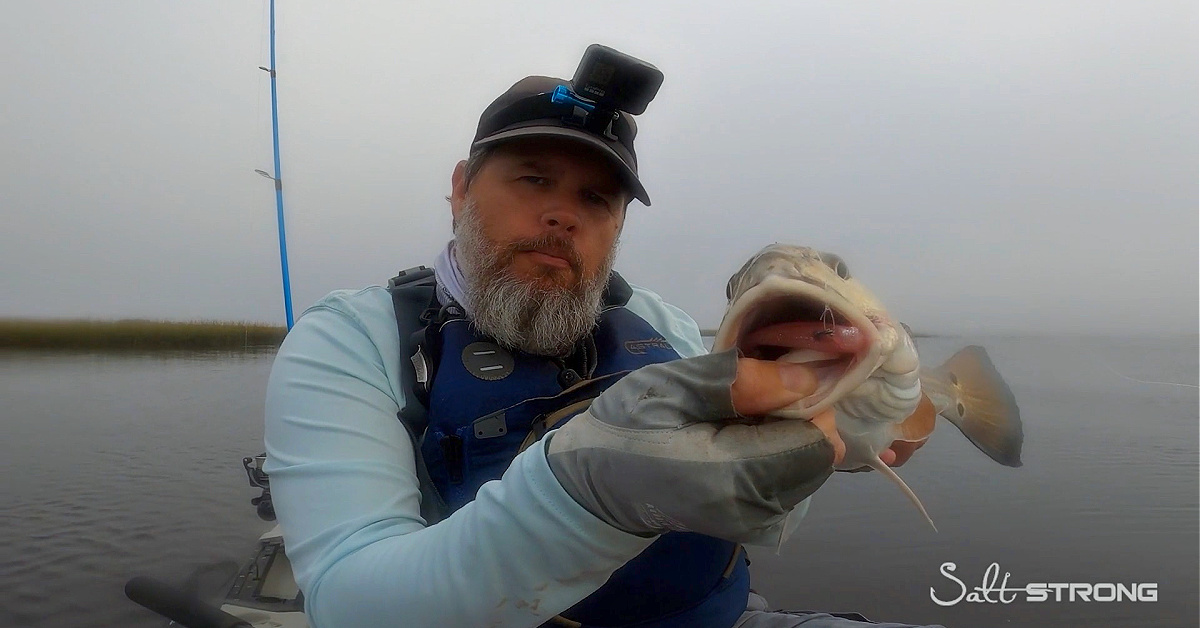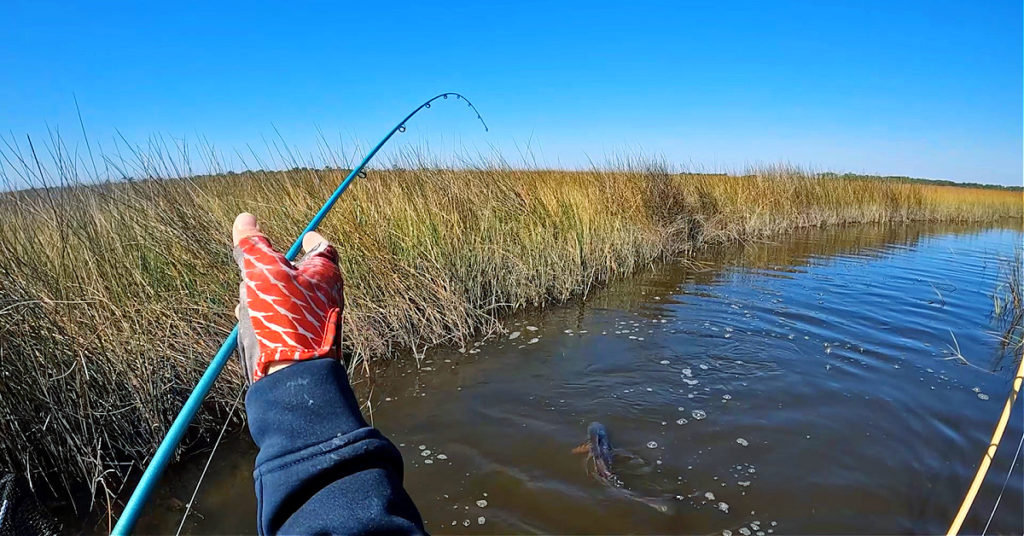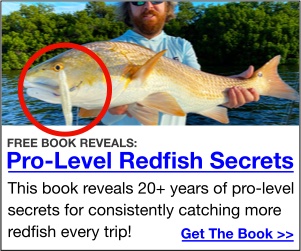Common Mistakes When First Starting To Fish Artificial Lures
- By: Pat Ogletree
- on

It’s time to correct these beginner artificial lure mistakes!!!
Whether you are first starting your fishing journey or you’ve been a live bait angler for a long time, the transition over to artificial lures is an obstacle but not one that you can’t overcome.
Learn more in the video right here!!
Beginner Artificial Lure Mistakes [VIDEO]

When you first see the entire selection of artificial lures at your local tackle store, it can be quite overwhelming.
There is everything from soft plastics, to hard-body lures, topwater lures, floaters, sinkers, and much, much more.
At this point, you’ll probably head online to search “inshore fishing lures” and be bombarded with thousands of results.
It’s nice to have a resource for endless information, but most of the time it is not relevant to you or where you SHOULD start.
Mistake #1: Getting Overwhelmed & Giving Up
The first and one of the most important things you can do is to gain confidence in any form of fishing you’re doing.
Whether that be artificial lures or live bait, you need confidence in your offering.
The only way to get confidence is to experience quick success.
Mistake #2: Trying Too Many Lures At The Beginning
After you hit the tackle shop and buy all the lures that catch your eye and think will catch fish, you’ll more than likely hit the water to try them out.
The mistake anglers often make is tying on one lure, throwing a few casts, then tying on another lure, throwing a few casts, and so on to try out all of the lures they bought.
Because you feel like you’re not catching, you’re not gaining any confidence in the lure.
Do your best to limit the number of lures you start out with in order to gain confidence in those first before moving on to more.
Mistake #3: Rigging Lures Incorrectly
With the wide variety of all different kinds of artificial lures, there are more than a few different rigging techniques.
Improperly rigging your artificial lures leads to unnatural presentations that simply turn fish away and spook them off rather than triggering strikes.
However, rigging artificial lures is NOT as challenging as it looks and with some repetition, this becomes second nature.
Mistake #4: Worrying Too Much About Color
Color is important but keep in mind that it takes a little while to be confident in an artificial lure.
Yes, there are some colors that will work better in some situations over other lure colors.
But, this is a topic that can dilute and overcomplicate things as you learn more about fishing with artificial lures.
Focus on one lure color and master that before moving on to others.
The best lure option for beginners is a white 3.5-inch paddletail lure.
Overall, a 3.5-inch lure will get you the most bites on a given day.
White is a lure color that works in every single water condition.
Yes, there are situations when a larger or smaller lure or a different color will outperform a white 3.5-inch paddletail, but this profile has you as a beginner ready to cast and catch fish.
Focus on catching fish on this lure and then you can start to branch out to other colors and profiles.
Furthermore, paddletails are one of, if not the, easiest lures to fish with.
You cast it out and reel it straight back to you.
If you are making the jump to artificial lures from live bait, not only are you completely flipping your approach but you also need to now impart action on an artificial lure.
Too many outstanding variables come into play for other lure types to be the first one you switch to use.
Paddletail Rigging Hooks, Techniques, & Retrieves
The first way to rig a paddletail is on a weighted rigging hook.
These hooks are best if you’re fishing in super skinny water of less than 3-4 feet.
When it comes to fishing in deeper water, rig the paddletail up on an open-faced jighead.
Jigheads sink quicker and get down to where those fish are in deeper water.
As I mentioned before, paddletails are worked using a simple, straight retrieve.
Yes, you can impart various actions on this lure, but for beginners, it’s best to just straight retrieve it back to you.
To know if you’re reeling at the right speed, you should feel a bump every few seconds and that is the bottom letting you know you’re in the strike zone.
Between these two hooks and a single lure profile, you can confidently catch fish in any region of the country.
Conclusion

The goal is to put you in the best situation to trigger as many strikes as possible.
Once you build up confidence in a white 3.5-inch paddletail, then you can begin to branch out and experiment with different lure styles.
This was my strategy back when I was making the switch from bass fishing to inshore saltwater fishing and it paid off BIG TIME.
What other questions come to mind regarding beginner artificial lure mistakes??
Let me know if you made any of these mistakes and how you were able to learn from and overcome them down in the comments!!
Finding The Fish Help
In order to help make sure that you are targeting the right areas based on the latest feeding trends and upcoming weather forecasts, make sure to use the following 3 resources because they will save you a ton of time.
1. Weekend Game Plans (updated weekly)
These regional game plans will show you exactly what types of spots to target in under 10 minutes… just click the video to start, and you’ll be informed on what to do on your next trip.
2. Smart Fishing Spots Platform (updated every 15 minutes)
This exclusive software literally shows you where the most fish are likely to be feeding based on exactly when you’ll be fishing. It factors in the tides, wind, and weather to help you quickly see which areas to target throughout the day.
3. Community Reports (live feed)
The Insider Community platform is what you can use to see what is biting near you, and you can get to know other members who fish in your area. Plus, you can use it to keep a log of your catches so you can use past trips to help predict future catches.
Related categories:
STOP WASTING TIME ON THE WATER!
Do what the “SMART ANGLERS” are doing and join the Insider Club.
Here’s what you’ll receive today when you join:
- Weekly fishing reports and TRENDS revealing exactly where you should fish every trip
- Weekly “spot dissection” videos that walk you through all the best spots in your area
- Exclusive fishing tips from the PROS you can’t find anywhere else
- Everything you need to start catching fish more consistently (regardless if you fish out of a boat, kayak, or land).










Thanks Pat
Thanks for making it simple Pat. Sometimes we get carried away in the tackle shop.
Thanks if only I had seen this earlier hope to use it soon!
What about hard lures
Absolutely great advice.. I’m rather new to say the least.. I think this club, advice, ect… is wonderful
Just got a bunch from SS. Was skunked first day out. Trying again tomorrow. Thanks for the info/
My son and I struggle with artificial but we do take a couple hours each trip to use them. I struggle with speed, never sure how fast to reel in the paddle tails, I will start to look out for the knock now.
Pat,
Super job. Thanks for simplifying things and I really appreciate that you are not going over the top with SS lures and jigheads. You make a lot of sense and I am not new to all of this but I find myself going out with gallon ziplock bags of lures (SS, Gulp and Zmann) and 4-6 rods. I really need to minimize my gear. Thank you and I will try to limit myself to the basics. Again I really appreciate your candor.
Thank you Tom!
Gear can get out of control quickly!
Great instructions on how to avoid my personal nemesis of paralysis from over analysis. Thanks
Appreciate it Scott!
I’m the same way sometimes, I definitely understand where you’re coming from!
Well said,
I got a biiiig tip that ALL inshore anglers need to know and that is study and read and know how to read and dish the tides you can be a master at all lures but unless your always fishing in mosquito lagoon where no tides come into play you REALLY need to be able to read and fish in different tidal situations whether it be incoming or outgoing thanks for the info and as always all you do😉👍
Tides ARE very important! Thanks for watching Steven!